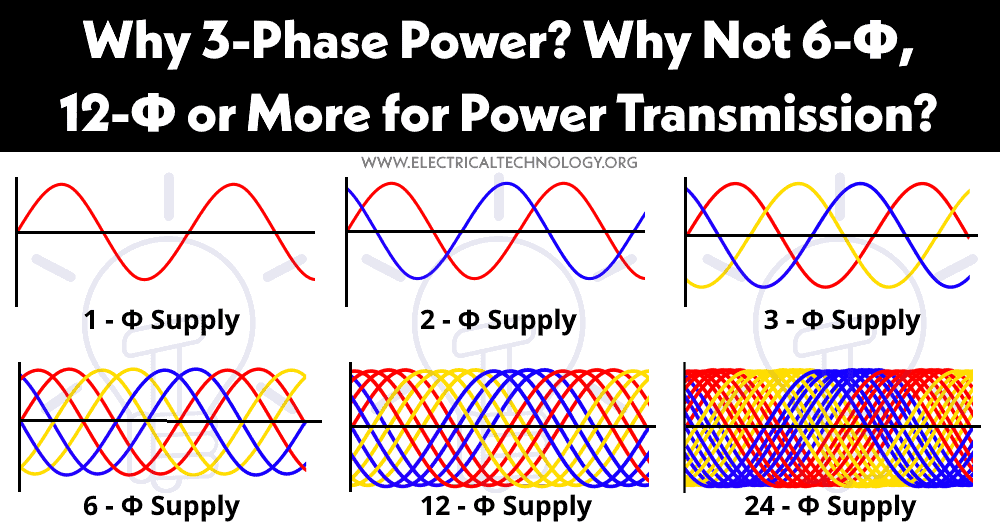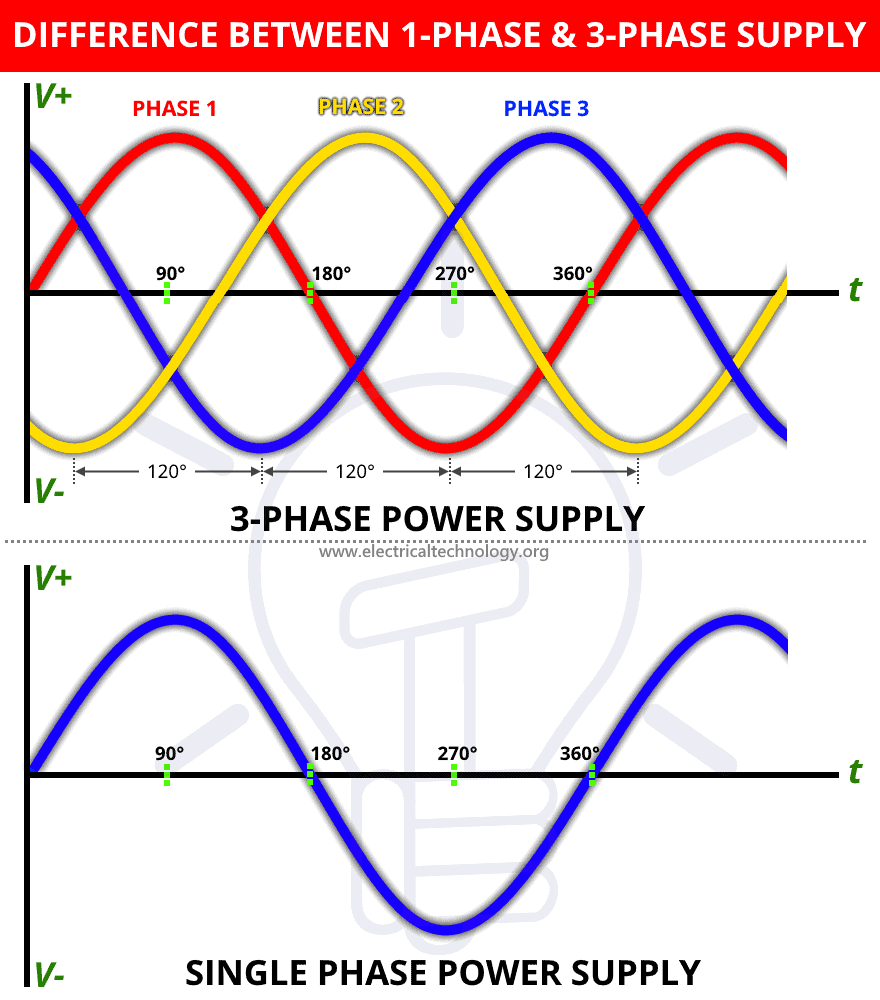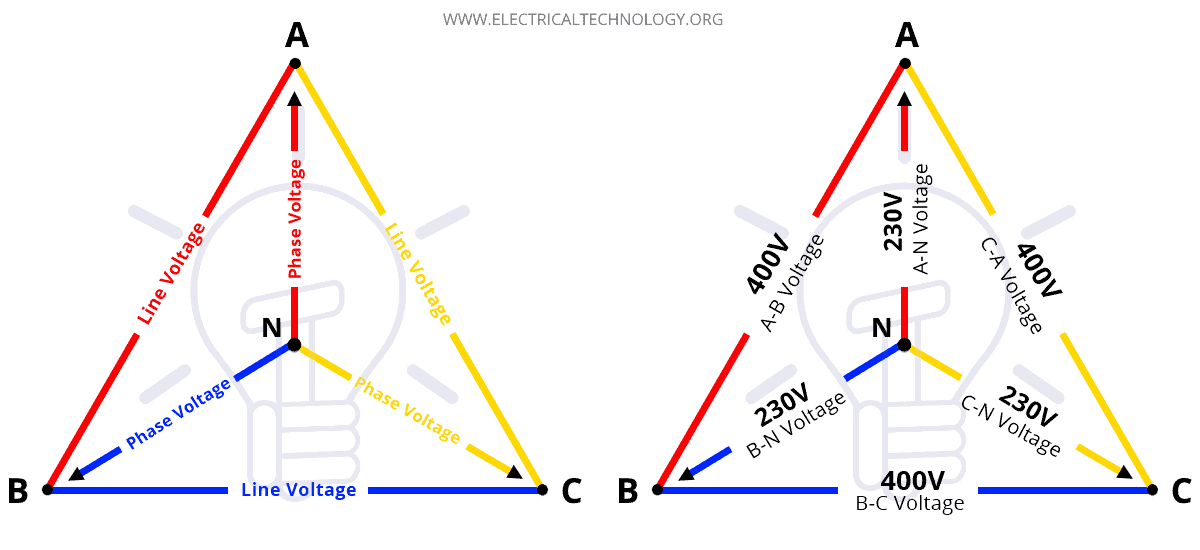Why 3-Phase Power? Why Not 6, 12 or More for Power Transmission?
Why is Only 3-Phase Power Supply System Used Instead of 2-Φ, 4-Φ, 6-Φ, 12-Φ or More Number of Phases for Power Transmission & Distribution?
We know that the most common supply systems for power transmission, distribution and utilization are Single Phase and Three Phase systems. There is a big difference between Single Phase and Three Phase supply systems where a three phase supply system has some advantages over a single phase supply system.
Keep in mind that there are multiple applications of 6-phase, 12-phase etc. for rectifier circuits, VFD and other uses in power electronics which help to reduce the ripple and pulsating DC. In addition, it is easy to get a different number of phases (like 6, 9 and 12 etc.) with the help of phase shifting and a motor generator set which was very complex somehow in the past , but it is not an economical system for power distribution and transmission over long distances.
Related Post: If a 1-Phase Supply is 230V, Why is 3-Phase 400V & Not 690V?
Why 3-Phase Instead of 1-Phase Supply System?
The main advantage of three phase over a single phase or two phase system is that we can transmit more (constant and uniform) power.
Power in Single Phase System
- P = V . I . CosФ
Power in Three Phase System
- P = √3 . VL . IL . CosФ … Or
- P = 3 x. VPH . IPH . CosФ
Where:
- P = Power in Watts
- VL = Line Voltage
- IL = Line Current
- VPH = Phase Voltage
- IPH = Phase Current
- CosФ = Power factor
Related Posts:
- Why Electric Power Transmission is Multiple of 11 i.e 11kV, 22kV, 66kV etc?
- Difference between AC and DC Transmission System & Power Lines
It clearly shows that the value of electric power in a three phase system is 1.732 (value of √3) times bigger than the power transmitted in a single phase supply system. Where two-phase supply tranmsit 1.141 time extra power than single phase power supply ststem.
In addition, there is RMF (rotating magnetic field) which helps in self-stating the three phase motors with constant instantaneous power and torque. On the other hand, these features and characteristics are not available in single phase supply systems i.e. no RMF and pulsating power
Also, there is less transmission loss and voltage drop in 3-phase. For example, in a typical resistive circuit;
Single Phase System
- Power loss in transmission line = 18I2r … (P = I2R)
- Voltage drop in transmission line = I.6r … (V = IR)
Three Phase System
- Power loss in transmission line = 9I2r … (P = I2R)
- Voltage drop in transmission line = I.3r … (V = IR)
It shows a 50% reduction in voltage drop and power loss in a three phase system as compared to a single phase system.
Now, There is also content power, produced RMF and constant torque in two phase supply same as three phase supply. But there is more power in 3-phase as compared to 2-Phase due to one extra number of phase. So the question arises here why not more phrases like 6, 9 12, 24, 48 etc. OK we will discuss in detail and also show how it is possible to transmit extra power in a three phase as compared to two phase with the same number of wires.
Related Posts:
- Difference Between Single Phase and Three Phase Power Supply
- Advantages of Three Phase System Over Single Phase System
Good to Know: There is 120° of phase angle between each phase in a three phase system while the phase angle between single phase (lagging or leading) and two phase are 90° (degrees).
Why Not 2-Phase? Why Only 3-Phase?
Well, If there is RMF, constant power and torque in both 2-phase and 3-phase systems then why use 3-phase instead of 2-phase system? Well, the reason is extra phase in a 3-phase system which carries extra power as compared to 2-phase system.
In addition, there are four wires needed to provide the supply from the generator to the load points (both phase pairs as Phase and neutral to complete the circuit). To eliminate the extra wire in two-phase four wire system, one common neutral wire is used which makes it a two-phase, three wire system but the returning amount of current from two phases is larger for common neutral, hence thicker conductor size (e.g. copper material) is needed for neutral.
Now, for the same reasons, the three wires (as phases in a 3-phase system) do the desired job with extra power as compared to a 2-phase system. In symmetrical and balanced load systems or delta configuration, three-phase, three wire system are used while in asymmetrical and unbalanced load or star configuration, three-phase, four wire system are used to achieve the desired features smoothly which are needed for power transmission and distribution.
Relates Posts:
- AC or DC ? Which One is More Dangerous And Why?
- Difference between AC and DC (Current & Voltage)
- Is Lightning AC or DC ?
Why Not 6-Φ, 9-Φ or 12-Φ instead of 3-Φ?
Well, one may ask if the increase in number of phases is advantageous, then why not to use more poly-phase systems like 6-phase, 9-phase, 12-phase or even more number of phases? As there is RMF, constant power and torque in the polyphase systems while the transmission loss and voltage are reduced by 50% by addition extra phase e.g. 4-phase, 5-phase, 7-phase, 24-phase, 48-phase or any other “n” number of phases. Why then only a 3-phase system among them?
The reason is simple. The least number among all of them is 3 which means we will be needing the least number conductor (3 in three phase as compared to 12 wires in a 12-phase system) while the overcome is almost the same. Also, the configuation of phase angle of 120 degrees between all phases in three phase system cancel out and elominate the third-harmonic and its multiples, if we opt out for 6, 9, 12 or more phases will only lead to extra cost of the mateials, complex design and additional maintinaces of the transmission & distibution lines as well as related switchgeas and potective equipoment.
Not only the conductors, in polyphase systems (like, 6, 9 or 12) we will redesign the overall systems (which leads to more complex systems) like each of 12 conductors, busbars, circuit breakers, power & distribution T/F, current (CT) and potential transformers etc. and increase in height of transmission towers, the space occupied by power and substation. That’s why we are restricting it to the three phase system instead of any other phase system.
Related Posts:
- Advantages of HVDC over HVAC Power Transmission
- Differences Between HVAC and HVDC & Power Transmission
- Advantages of Three Phase Transformer over Single Phase Transformer
- Difference Between Single Phase & Three Phase Induction Motor
- Delta Connection (Δ): 3 Phase Power, Voltage & Current Values
- Star Connection (Y): Three Phase Power, Voltage & Current Values
- Difference between Star and Delta Connections – Comparison Of Y/Δ
- Star to Delta & Delta to Star Conversion. Y-Δ Transformation
- Three Phase Current Values in a 3-Phase System
- What are the Different Colors Electrical Outlets Used for?
- Why are Outlets and Receptacles in Hospitals Upside Down?
- Why Does the Heating Element Glow but Not the Cord of Heater?
- What Happens if a Battery is Connected to the AC Supply?
- What Happens to the Battery with Reverse Polarity Wiring Connection
- Why are Stones laid in an Electrical Substation?
- Why is Zero Ohm Resistor Used? 0-Ω Resistor Applications
- How to Wire a Three Phase, 400V Distribution Board? IEC & UK
- Three Phase Electrical Wiring Installation in Home – NEC & IEC
- What happens if You Connect a 3-Φ Induction Motor to 1-Phase Supply?
- How to Run a Three-Phase Induction Motor on a Single-Phase Power Supply?












